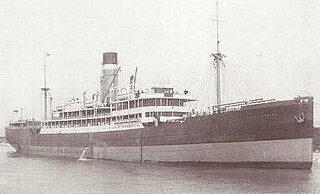
SS City of Venice was an intermediate ocean liner that was launched in 1924 in Northern Ireland for Ellerman Lines. In the Second World War she was a troop ship. In 1943 a U-boat sank her in the Mediterranean, killing 22 of the crew and troops aboard.
SS Assyrian was a cargo ship that was built in Hamburg for German owners in 1914, transferred to British owners in 1920 as war reparations and sunk by a U-boat in 1940. She was launched as MS Fritz, and when she changed owners in 1920 she was renamed MS Assyrian. She had been built as a motor ship but in 1925 she was converted to a steamship and became SS Assyrian.

SS Somersby was a British cargo steamship that was built in 1930, sailed in a number of convoys in the Second World War and was sunk by a U-boat in 1941.
SS Manistee was an Elders & Fyffes Ltd banana boat that was launched in 1920. She was one of a numerous class of similar banana boats built for Elders & Fyffes in the 1920s.
SS Tregenna was a cargo steamship that was launched in England in 1919 and sunk by a U-boat in the Battle of the Atlantic in 1940 with the loss of 33 of her 37 crew. She was laid down as War Bulldog, but the Hain Steam Ship Co bought her before she was completed and renamed her Tregenna.

SS Hilary was a British steam passenger liner that was built in 1931 and scrapped in 1959. She spent much of her career on a scheduled service between Liverpool in England and Manaus in Brazil.

Empire Endurance was a 8,514 GRT steam cargo liner that was built in 1928 as Alster by Deschimag Werk Vulkan, Hamburg, Germany for the shipping company Norddeutscher Lloyd. In the years leading up to the Second World War Alster carried cargo and passengers between Germany and Australia. After the outbreak of war she was requisitioned by the Kriegsmarine for use as a supply ship.
SS Yoma was a British passenger liner that served as a troop ship in the Second World War. She was built in Scotland in 1928, and from then until 1940 Yoma ran a regular route between Glasgow in Scotland and Rangoon in Burma via Liverpool, Palma, Marseille and Egypt. She became a troop ship in 1941 and was sunk with great loss of life in the Mediterranean in 1943.

SS Oropesa was a British steam turbine ocean liner of the Pacific Steam Navigation Company (PSNC). She was built on Merseyside in 1920 and operated between Liverpool and South America. In 1941 the German submarine U-96 sank her in the Western Approaches, killing 106 people aboard.
SS Clan Macarthur was a British refrigerated cargo steamship. She was built for Cayzer, Irvine and Company's Clan Line Steamers Ltd as one of its Cameron-class steamships. She was launched in Greenock in 1936 and sunk in the Indian Ocean by enemy action in August 1943.

SS Cyclops was a British cargo steamship of Alfred Holt and Company. She was built in Glasgow in 1906, served in both the First and Second World Wars and survived two German submarine attacks in 1917. A German submarine sank her in January 1942 off the coast of Nova Scotia, killing 87 of the men aboard her. This was the first attack of the Kriegsmarine's Unternehmen Paukenschlag to destroy Allied merchant shipping in the Western Atlantic.
SS City of Bedford was a British cargo steamship. She was launched in 1924 in Sunderland for Hall Line Ltd of Liverpool, a member of the Ellerman Lines group.
MV Henry Stanley was a UK cargo motor ship that traded between Liverpool and West Africa. She was launched in 1929 in Scotland and sunk in 1942 in the North Atlantic.
SS Huntingdon was a refrigerated steam cargo liner that was built in Germany in 1920 as Münsterland. The United Kingdom took her as war reparations and sold her to the Federal Steam Navigation Company, who renamed her Huntingdon. She operated between Britain and Australasia until 1941, when an Italian submarine sank her in the Atlantic Ocean.
SS Jumna was a steam passenger liner that was built in Scotland in 1929 and sunk with all hands by a German cruiser on Christmas Day 1940. She was a ship in the fleet of James Nourse, Ltd, whose trade included taking indentured labourers from India to the British West Indies.
SS Tregarthen was a cargo steamship that was built in Scotland for the Hain Steam Ship Co in 1936. She was sunk with all hands by a U-boat in 1941 in the Battle of the Atlantic.
SS Hartlebury was a cargo steamship that was launched in Scotland in 1934 for J&C Harrison Ltd. A U-boat sank her in the Barents Sea in 1942 when Hartlebury was a member of the Arctic convoy Convoy PQ 17.
SS Pennington Court was a British cargo steamship. She was launched in 1924 as Rochdale and renamed Pennington Court in 1927. In the Second World War she carried iron ore, grain and other supplies to Britain. She was sunk with all hands in the Battle of the Atlantic in 1942.
SS St. Elwyn was a cargo steamship that was built in England in 1938 and owned by the South American Saint Line. A German U-boat sank her in the Atlantic Ocean in 1940, with the loss of 24 of her crew.
HMS Salopian was a motor ship that was built in 1926 as the passenger ship Shropshire. She belonged to Bibby Line, which ran passenger and cargo services between Rangoon in Burma and various ports in Great Britain, via the Suez Canal and Gibraltar. The Admiralty requisitioned Shropshire in 1939, had her converted into an armed merchant cruiser (AMC), and renamed her Salopian. A German U-boat sank her in the Battle of the Atlantic in 1941.





